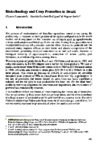Use este identificador para citar ou linkar para este item:
http://www.alice.cnptia.embrapa.br/alice/handle/doc/12833| Título: | Biotechnology and crop protection in Brazil. |
| Autoria: | CAMPANHOLA, C.  RODRIGUES, G. S.   BETTIOL, W.   |
| Afiliação: | CLAYTON CAMPANHOLA, EMBRAPA-CNPMA; GERALDO STACHETTI RODRIGUES, CNPMA; WAGNER BETTIOL, CNPMA. |
| Ano de publicação: | 1997 |
| Referência: | In: INTERNATIONAL CONFERENCE ON SUSTAINABLE AGRICULTURE IN TROPICAL AND SUBTROPICAL HIGHLANDS WITH SPECIAL REFERENCE TO LATIN AMERICA, 1997, Rio de Janeiro. Abstracts. Rio de janeiro: INT / EMBRAPA-SOLOS / University of Karlsruh, 1997. p. 283-290 |
| Páginas: | n.p. |
| Conteúdo: | The process of modernization of Brazilian agriculture aimed at increasing the productivity in response to the high demand for agricultural products in the world market and it was based on the intensive use of inputs such as agrochemicals, intense mechanisation and breeding of new varieties. Among these, pesticides were incorporated in almost all production systems. Over reliance on pesticide use has produced many negative effects on both biotic and abiotic components of the environment, generating chemical contamination of soil and water, decrease in biological diversity of agroecosystems, disruption of natural cycles, pest resistance, intoxication of growers, among others. The consumption of pesticides in Brazil was 151.8 thousand tonnes in 1989, and today the country is the fifth world market of these products. The use of pesticides increased from 16 thousand tonnes (a.i.) in 1964 to 60.2 thousand tonnes in 1991, while the area planted to crops grew from 28.4 to 50.0 million ha in the same period. This means an increase of 276.2% in consumption of pesticides compared to an increase of 76% in planted area. Even with this large increase in the use of pesticides, the losses caused by pests have not been significantly reduced, and the net gain in crop productivity has been low. On the other hand, problems with food contamination, environmental degradation of growers have considerably mounted. It is possible to define two classes of crops regarding intense use of pesticides. One is represented by those crops that occupy large areas, and therefore contribute to a large amont of pesticides used for pest control in a country basis. The other class comprises crops that require large amounts of pesticides per unit of area, but not necessarily represent large amounts of pesticides used coutry-wide. Based on the classes proposed, citrus, soybean and sugarcane stand as crops with a nationally great consumption of pesticides, while tomato, potato and citrus are important as intensive users of pesticides. In this paper the biotechnologies in use, the biotechnologies in advanced stages of development, the main constraints to the development and use of biotechnlology and the impact of pesticed on the environment are discussed. |
| Thesagro: | Biotecnologia |
| Tipo do material: | Artigo em anais e proceedings |
| Acesso: | openAccess |
| Aparece nas coleções: | Artigo em anais de congresso (CNPMA)  |
Arquivos associados a este item:
| Arquivo | Descrição | Tamanho | Formato | |
|---|---|---|---|---|
| 1996AA001CompanholaBiotechnology3420.pdf | 4,29 MB | Adobe PDF |  Visualizar/Abrir |









